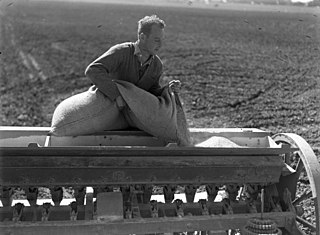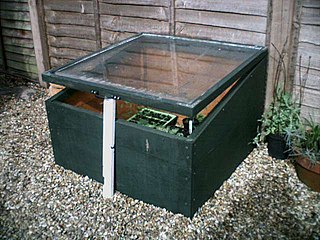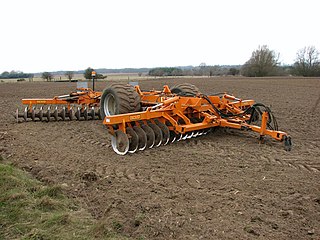
Tillage is the agricultural preparation of soil by mechanical agitation of various types, such as digging, stirring, and overturning. Examples of human-powered tilling methods using hand tools include shoveling, picking, mattock work, hoeing, and raking. Examples of draft-animal-powered or mechanized work include ploughing, rototilling, rolling with cultipackers or other rollers, harrowing, and cultivating with cultivator shanks (teeth).

In agriculture, a harrow is a farm implement used for surface tillage. It is used after ploughing for breaking up and smoothing out the surface of the soil. The purpose of harrowing is to break up clods and to provide a soil structure, called tilth, that is suitable for planting seeds. Coarser harrowing may also be used to remove weeds and to cover seed after sowing.

Weed control is a type of pest control, which attempts to stop or reduce growth of weeds, especially noxious weeds, with the aim of reducing their competition with desired flora and fauna including domesticated plants and livestock, and in natural settings preventing non native species competing with native species.
Vegan organicagriculture is the organic production of food and other crops with minimal animal inputs. Vegan organic agriculture is the organic form of animal-free agriculture.

In agriculture, cover crops are plants that are planted to cover the soil rather than for the purpose of being harvested. Cover crops manage soil erosion, soil fertility, soil quality, water, weeds, pests, diseases, biodiversity and wildlife in an agroecosystem—an ecological system managed and shaped by humans. Cover crops can increase microbial activity in the soil, which has a positive effect on nitrogen availability, nitrogen uptake in target crops, and crop yields. Cover crops may be an off-season crop planted after harvesting the cash crop. Cover crops are nurse crops in that they increase the survival of the main crop being harvested, and are often grown over the winter. In the United States, cover cropping may cost as much as $35 per acre.

A mulch is a layer of material applied to the surface of soil. Reasons for applying mulch include conservation of soil moisture, improving fertility and health of the soil, reducing weed growth, and enhancing the visual appeal of the area.

Vigna subterranea is a member of the family Fabaceae. Its name is derived from the Bambara ethnic group. The plant originated in West Africa. As a food and source of income, the Bambara groundnut is considered to be the third most important leguminous crop in those African countries where it is grown, after peanut and cowpea. The crop is mainly cultivated, sold and processed by women, and is, thus, particularly valuable for female subsistence farmers.

Dryland farming and dry farming encompass specific agricultural techniques for the non-irrigated cultivation of crops. Dryland farming is associated with drylands, areas characterized by a cool wet season followed by a warm dry season. They are also associated with arid conditions, areas prone to drought and those having scarce water resources.

Safflower is a highly branched, herbaceous, thistle-like annual plant in the family Asteraceae. It is commercially cultivated for vegetable oil extracted from the seeds and was used by the early Spanish colonies along the Rio Grande as a substitute for saffron. Plants are 30 to 150 cm tall with globular flower heads having yellow, orange, or red flowers. Each branch will usually have from one to five flower heads containing 15 to 20 seeds per head. Safflower is native to arid environments having seasonal rain. It grows a deep taproot which enables it to thrive in such environments.

A seed drill is a device used in agriculture that sows seeds for crops by positioning them in the soil and burying them to a specific depth while being dragged by a tractor. This ensures that seeds will be distributed evenly.

In agriculture and gardening, a cold frame is a transparent-roofed enclosure, built low to the ground, used to protect plants from adverse weather, primarily excessive cold or wet. The transparent top admits sunlight and prevents heat escape via convection that would otherwise occur, particularly at night. Essentially, a cold frame functions as a miniature greenhouse to extend the growing season.

Vigna aconitifolia is a drought-resistant legume, commonly grown in arid and semi-arid regions of India. It is commonly called mat bean, moth bean, matki or dew bean. The pods, sprouts and protein-rich seeds of this crop are commonly consumed in India. Moth bean can be grown on many soil types, and can also act as a pasture legume.

Cultivation of cannabis is the production of cannabis infructescences. Cultivation techniques for other purposes differ.

Juncus tenuis, the slender rush, is a clump-forming, round-stemmed perennial in the Juncaceae. Slender rush grows to be between 15 and 60 cm tall. Generally considered a weed, it is rarely sold by retailers as a household container plant. Where it is introduced, it is colloquially called path rush, field rush, slender yard rush, poverty rush or wiregrass.
Pythium irregulare is a soil borne oomycete plant pathogen. Oomycetes, also known as "water molds", are fungal-like protists. They are fungal-like because of their similar life cycles, but differ in that the resting stage is diploid, they have coenocytic hyphae, a larger genome, cellulose in their cell walls instead of chitin, and contain zoospores and oospores.

Pesticide application refers to the practical way in which pesticides are delivered to their biological targets. Public concern about the use of pesticides has highlighted the need to make this process as efficient as possible, in order to minimise their release into the environment and human exposure. The practice of pest management by the rational application of pesticides is supremely multi-disciplinary, combining many aspects of biology and chemistry with: agronomy, engineering, meteorology, socio-economics and public health, together with newer disciplines such as biotechnology and information science.

A weed is a plant considered undesirable in a particular situation, growing where it conflicts with human preferences, needs, or goals. Plants with characteristics that make them hazardous, aesthetically unappealing, difficult to control in managed environments, or otherwise unwanted in farm land, orchards, gardens, lawns, parks, recreational spaces, residential and industrial areas, may all be considered weeds. The concept of weeds is particularly significant in agriculture, where the presence of weeds in fields used to grow crops may cause major losses in yields. Invasive species, plants introduced to an environment where their presence negatively impacts the overall functioning and biodiversity of the ecosystem, may also sometimes be considered weeds.

A disc harrow is a harrow whose cutting edges are a row of concave metal discs, which may be scalloped or set at an oblique angle. It is an agricultural implement that is used to till the soil where crops are to be planted. It is also used to chop up unwanted weeds or crop residue.

Bensulide is a selective organophosphate herbicide. It is one of a few organophosphate compounds that are used as an herbicide. Most of the others are used as insecticides. It is used on vegetable crops such as carrots, cucumbers, peppers, and melons and in cotton and turfgrass to control annual grasses such as bluegrass and crabgrass and broadleaf weeds. It is often applied before the weed seeds germinate (pre-emergence) in order to prevent them from germinating. It is available as granules or an emulsifiable concentrate. Estimates place the total use of bensulide in the United States at about 632,000 pounds annually. Application rates may be relatively heavy when it is used. The EPA classifies bensulide as a general use pesticide.
This glossary of agriculture is a list of definitions of terms and concepts used in agriculture, its sub-disciplines, and related fields, including horticulture, animal husbandry, agribusiness, and agricultural policy. For other glossaries relevant to agricultural science, see Glossary of biology, Glossary of ecology, Glossary of environmental science, and Glossary of botanical terms.
















